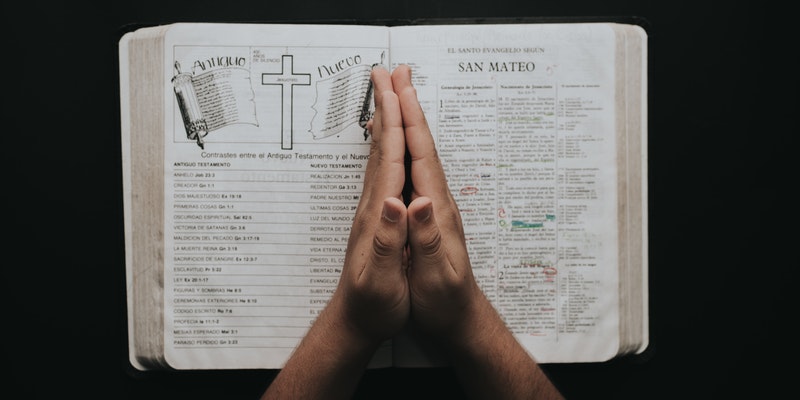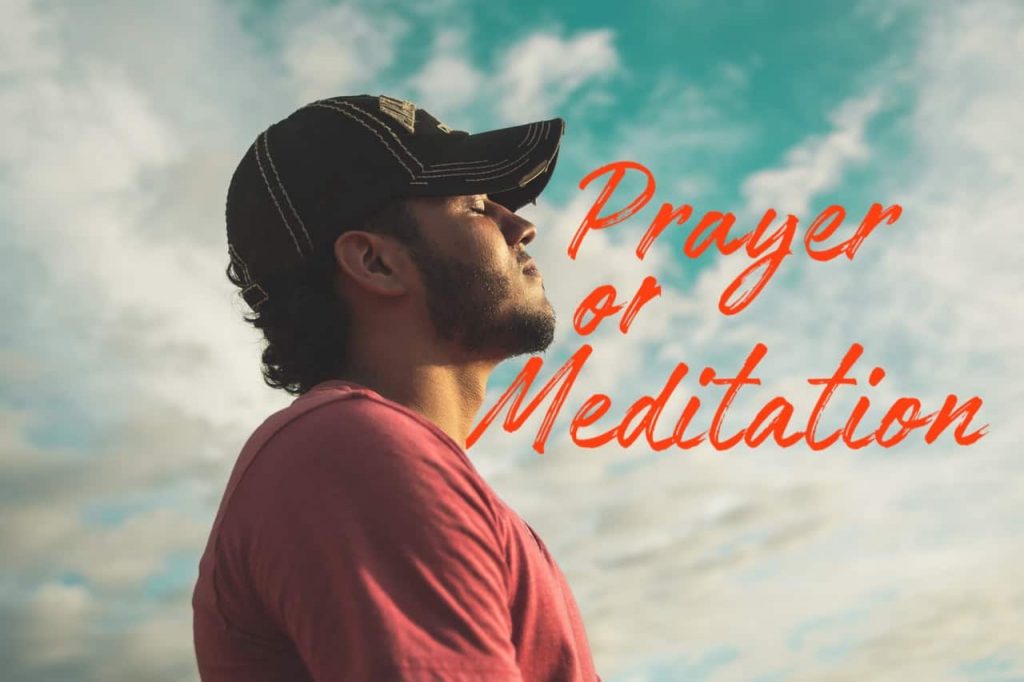At the core of it, meditation and prayer are almost the same. Both practices involve people sitting still and reflecting on the inner self and inner thoughts. Prayer and meditation are undertaken with good intentions and they tend to enhance your mind, body, and soul and also make your personality better.

The prime focus of the two practices, however, are not the same. The best way to differentiate the two is that prayers usually look up while meditations look within
We often get confused between “meditation” and “prayer” and sometimes even use these two terms synonymously.
Where do Prayer and Meditation intersect?
Praying is usually more goal-oriented, meditation is relatively less goal-oriented and non-striving. But still, they are common in several ways. Prayer and meditation take place in solitude and they both are usually undertaken in a peaceful and serene setting where there is a contemplative and inward state of feeling.
[cta]
There is less or no outward stimulus in both praying and meditation. People who meditate or pray, tend to be surrounded by a spectacular environment which is soothing to them and others.
You Can Submit a Prayer Request on Our Prayer Wall – View it here
At the core of it, meditation and prayer are almost the same. Both practices involve people sitting still and reflecting on the inner self and inner thoughts. Prayer and meditation are undertaken with good intentions and they tend to enhance your mind, body, and soul and also make your personality better.

Many religions require various accompaniments to follow the practices of meditation and prayer and these common accompaniments arouse the feeling of union and reverence. The accompaniments include reverberating music, votive offerings, use of ritual phrases chanted repetitively, echoing the chants and common closing of the eyes, candlelight, burning of incense sticks and cones, the echoing sounds of the ringing bells, the special sustained poise and posture and the decorations that have symbolic significance. There is a difference between Adventist & Christian
These elements are supportive accompaniments in both the practices of prayer and meditation and these arouse the mood in an extremely effective way.
The prime focus of the two practices, however, are not the same. The best way to differentiate the two is that prayers usually look up while meditations look within. But no matter what you do; whether you pray to the higher almighty or meditate within your soul, you will alter your life for the betterment of yourself and others.
Theoretically, there are about 7 billion types of meditations and prayers all over the world. And they can be undertaken either silently or verbally.
Both prayer and meditation are filled with concentrated thoughts but their goals are not the same.
What is Prayer?

According to the Bible, prayer is an act of speaking to God. It is the means of communicating our needs, desires, and our deepest thoughts to Him. Hence, prayer is not an attitude, it is merely an act of talking to the higher power.
Submit a prayer request for everyone to view
The subject of the prayer may differ from person to person. It tries to use a person’s inner thoughts and desires that influence his outer world. When someone prays, he begins with a different sense of oneself that is eager to take help from the higher power. This higher power can be anyone or anything in which he believes. The higher power can be the divine nature, the universe, the God Almighty, etc.
Monotheistic religions such as Christianity, Islam, and Judaism practice the act of praying and it is an integral part of these religions.
While praying, they send their thoughts and wishes to God and praise him. Their prayers are usually goal-oriented which means that people pray for something – for the sick, for the betterment of someone or the less fortunate people. Prayers can be for forgiveness too.
What is Meditation?
Meditation is both an act as well as a skill. One needs to acquire the skill of removing the judgment component from the thoughts or ideas. It is a form of mental training or exercise whereby you exercise your brain to be relaxed, focussed, and fully aware. What physical workout does to the body; meditation does to the mind. Usually, the act of meditation is performed individually, in a still and calm seated position, with your eyes wholly or partially closed.
While meditation is found in every part of the world, most of it comes from the religion of Buddhism, founded by Siddhartha Gautama or Buddha.
Can religious people meditate?
Yes, religious people can meditate. There are different forms of meditation depending on religion. They have their unique orientation and style of meditation. Hinduism, Adventism, Buddhism, Christianity, Islam, and Judaism are some of the religions that practice different forms of meditations. The techniques may vary but the aim is the same no matter which religion you belong to. Read everything that makes Adventist Different
How to Pray?

The following are a few steps that will guide you to pray religiously, every day.
Step 1 – Do Not Hurry While Praying
It does not matter to whom you pray or how many times you pray if you do not pray properly and give ample time to pray. Even during difficult or busy times, you should ensure that you are not hasty while praying. You can pray either before going to sleep, before every meal or after you wake up in the morning. There is no specific time to pray.
Step 2 – Find a Quiet Spot
While you can pray anywhere you want, or anytime or anyhow you want to, you may find it easier to pray if you find the correct spot or place. There is no denying that the focus of the spot must be on spirituality like a temple or a church. The place should be quiet and free from all kinds of hustle and bustle. There should not be any sort of pandemonium around you. You can pray with a congregation or on your own, it does not matter with whom you are praying.
Step 3- Know What You Are Praying For
A prayer is goal-oriented, which means prayer is accompanied by a purpose, and based on the purpose, rituals are chosen. The rituals can be varying from purpose to purpose; there can be a lengthy and scorching fire-burning session, during which the people offer sacrifices to the higher power to make sure that good luck falls upon them or it can be as simple as a thoughtful utterance of a few lines of prayer before a meal. Sometimes, prayers do not involve a question or a request or a wish, it may only be a message of appreciation and thankfulness. It is just a one-way conversation with God.
Step 4 – Prepare Yourself into A Prayer Position
The prayer position often varies from person to person and from religion to religion. It solely depends on the beliefs of the person. Some may feel they can express more while sitting down while others feel the need to kneel during prayer. The position varies from lying down on the ground, standing with head bowed down, whirling or dancing, holding hands or swaying, etc. While some pray with their eyes wide open, others pray with their eyes partially or wholly closed.
Step 5 – Initiate the prayer
The act of praying can be performed by singing, thinking, or by chanting the prayer out loud. Some prayers are read from a religious book or spoken from memory. There is no right or wrong way to pray. When you end the prayer, use special words or actions or phrases to indicate that the prayer has ended. Once you know the prayer has ended, you can remove yourself from the position and go about your normal daily activities.
Read a full guide on how to pray
How to Meditate?

The following are a few steps on how to meditate –
Step 1 – Find a quiet and comfortable place to meditate
The spot you choose for meditation should be private, comfortable, quiet, and free from all outside disturbances. Your spot can be in your bedroom or an open field. The aim is to sit upright while still being comfortable. Relax your muscles. Remove all the tension and worries from your mind and practice the art of meditation properly.
Step 2 – Sit in a comfortable Position and Close Your Eyes
The sitting position does not matter as long as it is comfortable and the energy is flowing without any obstruction. It can be a lotus position, cross-legged position, or seated on a chair. Gently close your eyes and take some deep breaths to calm your body. After a few cleansing breaths, you can breathe at a normal pace through your nose.
Step 3 – Remove all thoughts from your mind
Empty your mind. There should not be any thoughts or ideas revolving around. Take deep breaths to calm your mind as well. Loosen all your body muscles and relax by the vibrations of the chant ohms.
Step 4 – Sit Back and Observe
f you sit back and observe your mind, you will find that your mind continues to function. You can allow your mind to think but do not engage actively. Be an observer of your mind.
Step 5 – End of Meditation
When you end your meditation, do not end abruptly. End it slowly by starting off being present in the physical reality. Gradually get your mind and body attuned to the surrounding.
Both meditation and prayer activate the same part of the brain. The difference is how you are activating it. Prayer is often times outwards looking up and out to someone else. In contrast meditation is often inward where you become more self aware and are able to more easily focus on what is important.
It depends on you. Some people prefer to pray to a deity while others love the self gratification of knowing you are able to become more aware of yourself. It’s up to you.
Absolutely! you do not have to pray to someone or something. You can simply know that there is a greater power that exists and know that you are being looked after.




